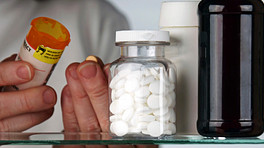Current studies show "a moderate benefit" for glucosamine sulfate and a slightly greater benefit for glucosamine sulfate and chondroitin sulfate when used for knee osteoarthritis or hip osteoarthritis to treat pain 1 Loes M, "Natural Medicine and Pain Relievers: A Review," Natural Medicine Online. . The 2005 presentation of the American College of Rheumatology’s results in the Glucosamine/Chondroitin Arthritis Intervention Trial (GAIT) support these findings.
Nearly 1,600 patients with x-ray evidence of knee osteoarthritis who had been experiencing significant joint pain were enrolled in the 24-week trial. Of a group of prespecified patients with moderate-to-severe knee pain who were assigned to take glucosamine and chondroitin in combination, 79% reported experiencing pain relief compared to 54% with placebo. A follow-up trial with these patients concluded in 2010 and found that although the use of glucosamine and chondroitin sulfate proved beneficial, there were no significant trends.
In This Article:
- Glucosamine and Chondroitin Sulfate Supplements for Osteoarthritis
- How Glucosamine and Chondroitin Help with Osteoarthritis
- Summary of Glucosamine and Chondroitin Studies
- Glucosamine and Chondroitin Sulfate Side Effects
The only study that examined results for treatment of osteoarthritis of the spine did not have a large enough number of patients to support or reject the use of glucosamine sulfate and/or chondroitin sulfate. However, the authors felt the supplements to be a reasonable treatment for osteoarthritis of the spine given the low incidence of side effects, other available evidence supporting their use, and the lack of more effective traditional medical treatments.
It should be emphasized that with the current studies, there is no conclusive evidence that glucosamine sulfate or chondroitin sulfate prevents or reverses the process of joint degeneration that leads to osteoarthritis. Future studies are needed to make such conclusions.
The following summary is based on the reviewed studies:
- Typical dosage is 1500mg for glucosamine sulfate and 1200mg for chondroitin sulfate, taken once daily. For body weight less than 100 lbs, the dose is generally reduced to 1000mg for glucosamine sulfate and 800mg for chondroitin sulfate.
- Duration of treatment has not yet been determined.
- Reported improvement (e.g. reduction in painful symptoms) varies from three weeks to as much as eight weeks.
- Some studies have shown continued improvement of symptoms after oral intake was stopped.
- Generally, if there is no pain reduction after two months, there is little chance of improvement.
Patients should keep a diary of their osteoarthritis symptoms when treatment begins to better judge any changes in pain level or joint movement, and this information should be shared with their physician.
- 1 Loes M, "Natural Medicine and Pain Relievers: A Review," Natural Medicine Online.











